不定式和分词作状语,独立成分,独立主格结构和with复合结构(24张)
- 格式:pptx
- 大小:2.01 MB
- 文档页数:24
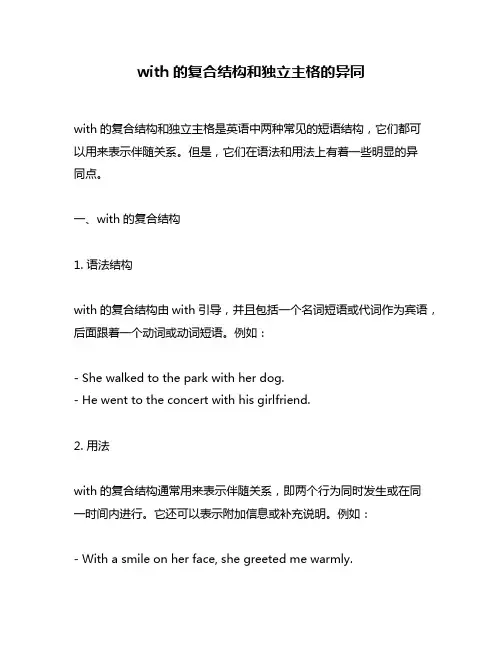
with的复合结构和独立主格的异同with的复合结构和独立主格是英语中两种常见的短语结构,它们都可以用来表示伴随关系。
但是,它们在语法和用法上有着一些明显的异同点。
一、with的复合结构1. 语法结构with的复合结构由with引导,并且包括一个名词短语或代词作为宾语,后面跟着一个动词或动词短语。
例如:- She walked to the park with her dog.- He went to the concert with his girlfriend.2. 用法with的复合结构通常用来表示伴随关系,即两个行为同时发生或在同一时间内进行。
它还可以表示附加信息或补充说明。
例如:- With a smile on her face, she greeted me warmly.- He left the party early with a headache.二、独立主格1. 语法结构独立主格是指一个名词短语或代词加上一个动名词,它们之间没有任何连接词。
例如:- The sun having set, we made our way back home.- Me being sick, I couldn't go to work today.2. 用法独立主格也表示伴随关系,但它更侧重于描述先决条件或原因。
通常情况下,独立主格放在句子的开头,用逗号与主句分开。
例如:- The weather being nice, we decided to have a picnic.- Her parents having died, she was left alone in the world.三、异同点1. 语法结构with的复合结构和独立主格在语法结构上有很大的差别。
前者是一个介词短语加上一个宾语和动词,后者则是一个名词短语或代词加上一个动名词。
2. 用法虽然两种结构都可以表示伴随关系,但是它们在用法上有一些不同。
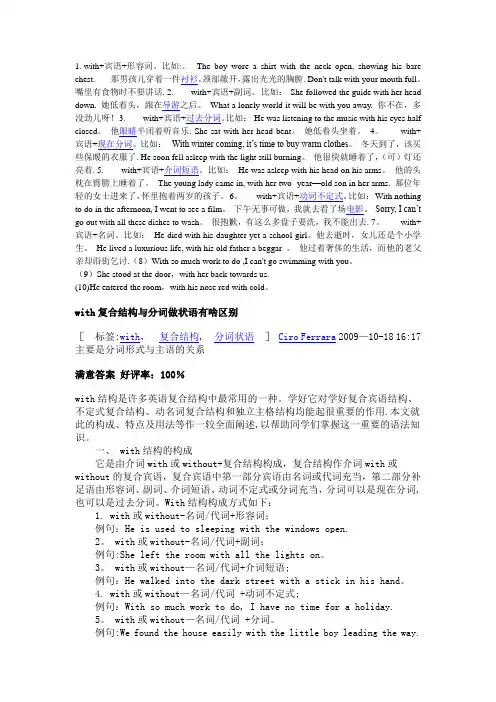
1. with+宾语+形容词。
比如:。
The boy wore a shirt with the neck open, showing his bare chest. 那男孩儿穿着一件衬衫,颈部敞开,露出光光的胸膛. Don't talk with your mouth full。
嘴里有食物时不要讲话.2. with+宾语+副词。
比如: She followed the guide with her head down. 她低着头,跟在导游之后。
What a lonely world it will be with you away. 你不在,多没劲儿呀!3. with+宾语+过去分词。
比如: He was listening to the music with his eyes half closed。
他眼睛半闭着听音乐. She sat with her head bent。
她低着头坐着。
4。
with+宾语+现在分词。
比如:With winter coming, it’s time to buy warm clothes。
冬天到了,该买些保暖的衣服了. He soon fell asleep with the light still burning。
他很快就睡着了,(可)灯还亮着. 5. with+宾语+介词短语。
比如:He was asleep with his head on his arms。
他的头枕在臂膀上睡着了。
The young lady came in, with her two- year—old son in her arms. 那位年轻的女士进来了,怀里抱着两岁的孩子。
6。
with+宾语+动词不定式。
比如:With nothing to do in the afternoon, I went to see a film。
下午无事可做,我就去看了场电影。
Sorry, I can’t go out with all these dishes to wash。
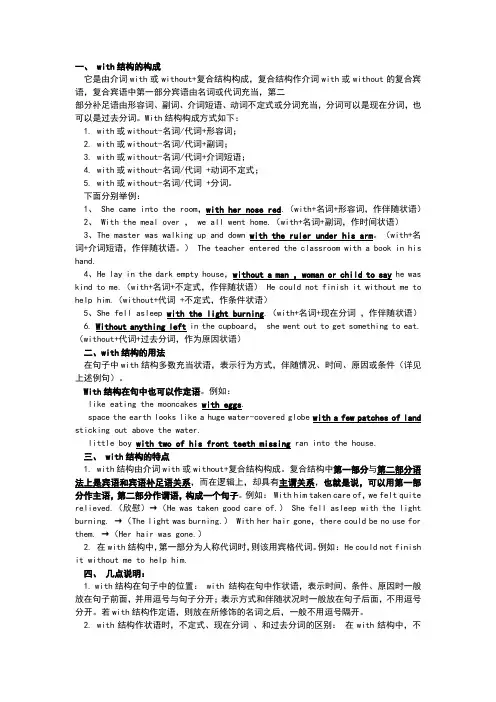
一、 with结构的构成它是由介词with或without+复合结构构成,复合结构作介词with或without的复合宾语,复合宾语中第一部分宾语由名词或代词充当,第二部分补足语由形容词、副词、介词短语、动词不定式或分词充当,分词可以是现在分词,也可以是过去分词。
With结构构成方式如下:1. with或without-名词/代词+形容词;2. with或without-名词/代词+副词;3. with或without-名词/代词+介词短语;4. with或without-名词/代词 +动词不定式;5. with或without-名词/代词 +分词。
下面分别举例:1、 She came into the room,with her nose red.(with+名词+形容词,作伴随状语)2、 With the meal over , we all went home.(with+名词+副词,作时间状语)3、The master was walking up and down with the ruler under his arm。
(with+名词+介词短语,作伴随状语。
) The teacher entered the classroom with a book in his hand.4、He lay in the dark empty house,without a man ,woman or child to say he was kind to me.(with+名词+不定式,作伴随状语) He could not finish it without me to help him.(without+代词 +不定式,作条件状语)5、She fell asleep with the light burning.(with+名词+现在分词,作伴随状语)6. Without anything left in the cupboard, she went out to get something to eat.(without+代词+过去分词,作为原因状语)二、with结构的用法在句子中with结构多数充当状语,表示行为方式,伴随情况、时间、原因或条件(详见上述例句)。
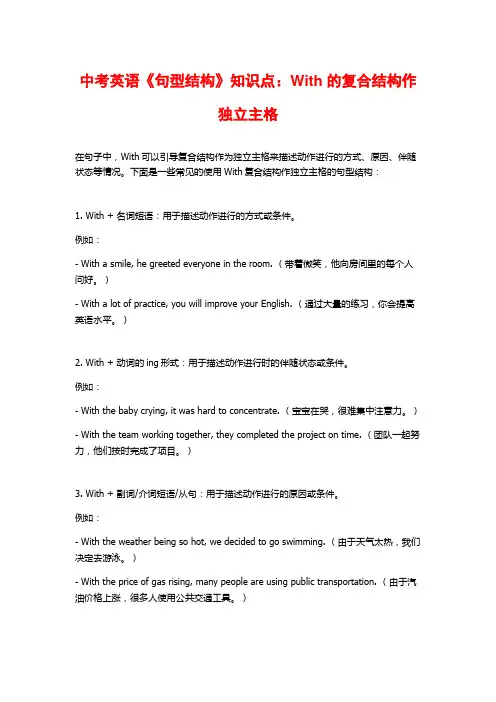
中考英语《句型结构》知识点:With的复合结构作独立主格在句子中,With可以引导复合结构作为独立主格来描述动作进行的方式、原因、伴随状态等情况。
下面是一些常见的使用With复合结构作独立主格的句型结构:1. With + 名词短语:用于描述动作进行的方式或条件。
例如:- With a smile, he greeted everyone in the room. (带着微笑,他向房间里的每个人问好。
)- With a lot of practice, you will improve your English. (通过大量的练习,你会提高英语水平。
)2. With + 动词的ing形式:用于描述动作进行时的伴随状态或条件。
例如:- With the baby crying, it was hard to concentrate. (宝宝在哭,很难集中注意力。
)- With the team working together, they completed the project on time. (团队一起努力,他们按时完成了项目。
)3. With + 副词/介词短语/从句:用于描述动作进行的原因或条件。
例如:- With the weather being so hot, we decided to go swimming. (由于天气太热,我们决定去游泳。
)- With the price of gas rising, many people are using public transportation. (由于汽油价格上涨,很多人使用公共交通工具。
)需要注意的是,With的复合结构作独立主格时,常与主谓语动词形成非限制性定语从句的关系,可以省略关系代词或并列连词(如that, which, and)。
希望以上内容对你有所帮助!。
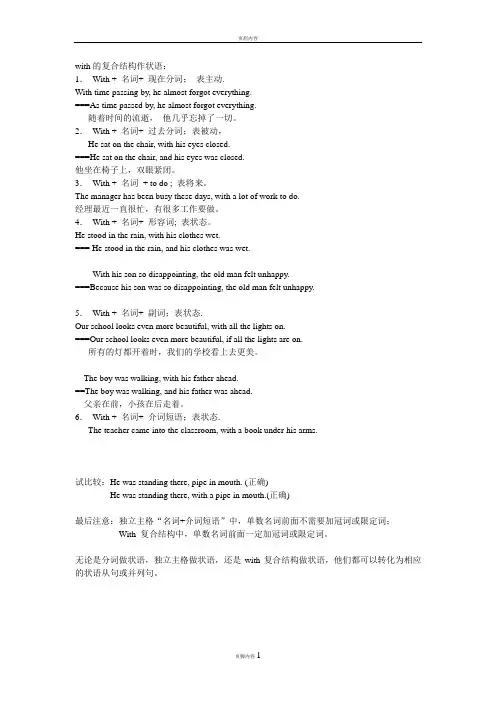
页眉内容with的复合结构作状语:1.With + 名词+ 现在分词;表主动.With time passing by, he almost forgot everything.===As time passed by, he almost forgot everything.随着时间的流逝,他几乎忘掉了一切。
2.With + 名词+ 过去分词;表被动,He sat on the chair, with his eyes closed.===He sat on the chair, and his eyes was closed.他坐在椅子上,双眼紧闭。
3.With + 名词+ to do ; 表将来。
The manager has been busy these days, with a lot of work to do.经理最近一直很忙,有很多工作要做。
4.With + 名词+ 形容词; 表状态。
He stood in the rain, with his clothes wet.=== He stood in the rain, and his clothes was wet.With his son so disappointing, the old man felt unhappy.===Because his son was so disappointing, the old man felt unhappy.5.With + 名词+ 副词;表状态.Our school looks even more beautiful, with all the lights on.===Our school looks even more beautiful, if all the lights are on.所有的灯都开着时,我们的学校看上去更美。
The boy was walking, with his father ahead.==The boy was walking, and his father was ahead.父亲在前,小孩在后走着。
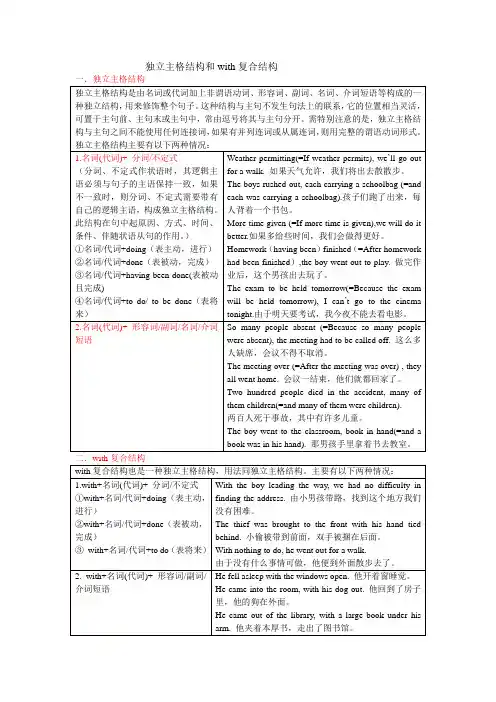
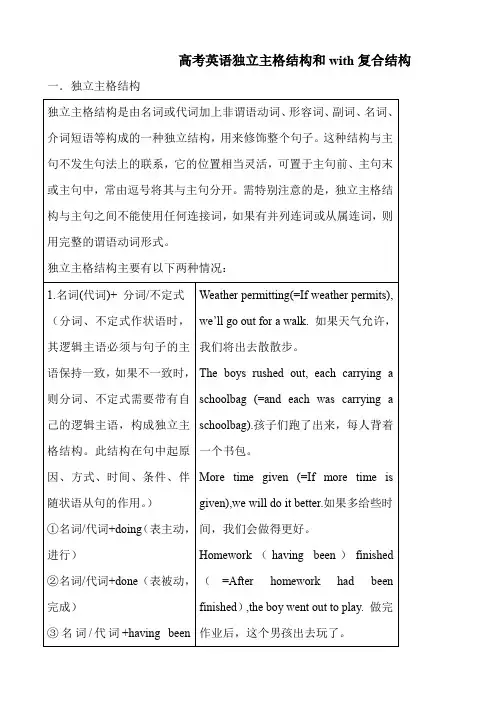
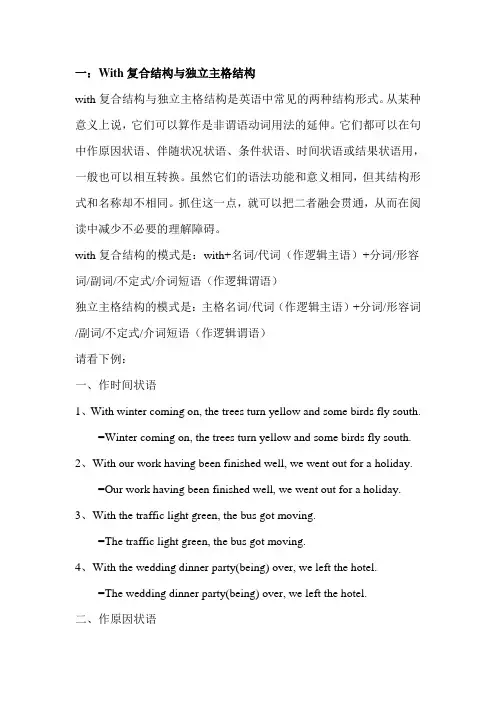
一:With复合结构与独立主格结构with复合结构与独立主格结构是英语中常见的两种结构形式。
从某种意义上说,它们可以算作是非谓语动词用法的延伸。
它们都可以在句中作原因状语、伴随状况状语、条件状语、时间状语或结果状语用,一般也可以相互转换。
虽然它们的语法功能和意义相同,但其结构形式和名称却不相同。
抓住这一点,就可以把二者融会贯通,从而在阅读中减少不必要的理解障碍。
with复合结构的模式是:with+名词/代词(作逻辑主语)+分词/形容词/副词/不定式/介词短语(作逻辑谓语)独立主格结构的模式是:主格名词/代词(作逻辑主语)+分词/形容词/副词/不定式/介词短语(作逻辑谓语)请看下例:一、作时间状语1、With winter coming on, the trees turn yellow and some birds fly south.=Winter coming on, the trees turn yellow and some birds fly south.2、With our work having been finished well, we went out for a holiday.=Our work having been finished well, we went out for a holiday. 3、With the traffic light green, the bus got moving.=The traffic light green, the bus got moving.4、With the wedding dinner party(being) over, we left the hotel.=The wedding dinner party(being) over, we left the hotel.二、作原因状语5、With it being Sunday, the library was closed.=It being Sunday, the library was closed.6、With the weather terribly cold, we entered the room to warm ourselves.=The weather terribly cold, we entered the room to warm ourselves. 7、With us to care for the children you are able to be carefree away from home.=We to care for the children, you are able to be carefree away from home.(注意此处的we 不得改成us,用了us便不是独立主格结构了。
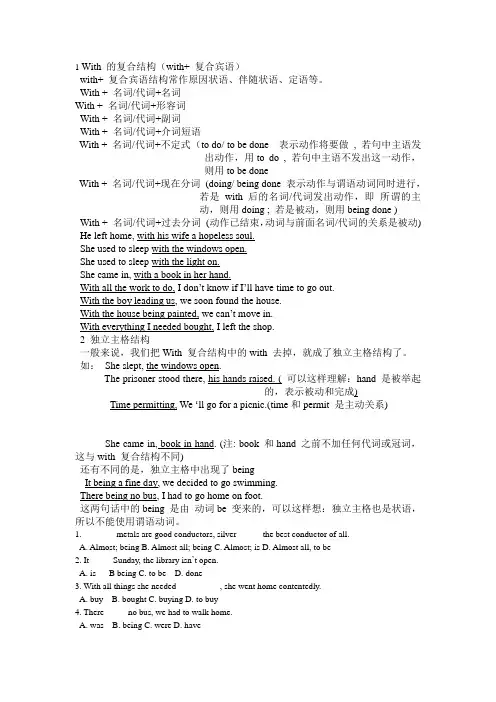
1 With 的复合结构(with+ 复合宾语)with+ 复合宾语结构常作原因状语、伴随状语、定语等。
With + 名词/代词+名词With + 名词/代词+形容词With + 名词/代词+副词With + 名词/代词+介词短语With + 名词/代词+不定式(to do/ to be done 表示动作将要做, 若句中主语发出动作,用to do , 若句中主语不发出这一动作,则用to be doneWith + 名词/代词+现在分词(doing/ being done 表示动作与谓语动词同时进行,若是with 后的名词/代词发出动作,即所谓的主动,则用doing ; 若是被动,则用being done )With + 名词/代词+过去分词(动作已结束,动词与前面名词/代词的关系是被动) He left home, with his wife a hopeless soul.She used to sleep with the windows open.She used to sleep with the light on.She came in, with a book in her hand.With all the work to do, I don’t know if I’ll have time to go out.With the boy leading us, we soon found the house.With the house being painted, we can’t move in.With everything I needed bought, I left the shop.2 独立主格结构一般来说,我们把With 复合结构中的with 去掉,就成了独立主格结构了。
如:She slept, the windows open.The prisoner stood there, his hands raised. ( 可以这样理解:hand 是被举起的,表示被动和完成)Time permitting, We ‘ll go for a picnic.(time和permit 是主动关系)She came in, book in hand. (注: book 和hand 之前不加任何代词或冠词,这与with 复合结构不同)还有不同的是,独立主格中出现了beingIt being a fine day, we decided to go swimming.There being no bus, I had to go home on foot.这两句话中的being 是由动词be 变来的,可以这样想:独立主格也是状语,所以不能使用谓语动词。
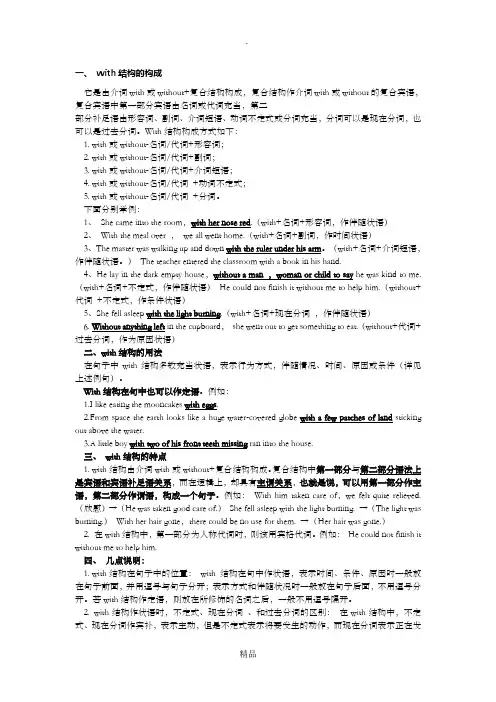
一、with结构的构成它是由介词with或without+复合结构构成,复合结构作介词with或without的复合宾语,复合宾语中第一部分宾语由名词或代词充当,第二部分补足语由形容词、副词、介词短语、动词不定式或分词充当,分词可以是现在分词,也可以是过去分词。
With结构构成方式如下:1. with或without-名词/代词+形容词;2. with或without-名词/代词+副词;3. with或without-名词/代词+介词短语;4. with或without-名词/代词+动词不定式;5. with或without-名词/代词+分词。
下面分别举例:1、She came into the room,with her nose red.(with+名词+形容词,作伴随状语)2、With the meal over ,we all went home.(with+名词+副词,作时间状语)3、The master was walking up and down with the ruler under his arm。
(with+名词+介词短语,作伴随状语。
)The teacher entered the classroom with a book in his hand.4、He lay in the dark empty house,without a man ,woman or child to say he was kind to me.(with+名词+不定式,作伴随状语)He could not finish it without me to help him.(without+代词+不定式,作条件状语)5、She fell asleep with the light burning.(with+名词+现在分词,作伴随状语)6. Without anything left in the cupboard,she went out to get something to eat.(without+代词+过去分词,作为原因状语)二、with结构的用法在句子中with结构多数充当状语,表示行为方式,伴随情况、时间、原因或条件(详见上述例句)。
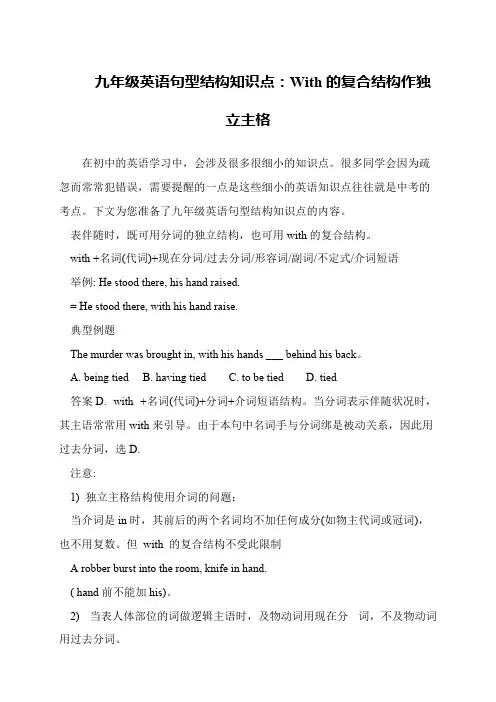
九年级英语句型结构知识点:With的复合结构作独
立主格
在初中的英语学习中,会涉及很多很细小的知识点。
很多同学会因为疏忽而常常犯错误,需要提醒的一点是这些细小的英语知识点往往就是中考的考点。
下文为您准备了九年级英语句型结构知识点的内容。
表伴随时,既可用分词的独立结构,也可用with的复合结构。
with +名词(代词)+现在分词/过去分词/形容词/副词/不定式/介词短语
举例: He stood there, his hand raised.
= He stood there, with his hand raise.
典型例题
The murder was brought in, with his hands ___ behind his back。
A. being tied B. having tied C. to be tied D. tied
答案D. with +名词(代词)+分词+介词短语结构。
当分词表示伴随状况时,其主语常常用with来引导。
由于本句中名词手与分词绑是被动关系,因此用过去分词,选D.
注意:
1) 独立主格结构使用介词的问题:
当介词是in时,其前后的两个名词均不加任何成分(如物主代词或冠词),也不用复数。
但with 的复合结构不受此限制
A robber burst into the room, knife in hand.
( hand前不能加his)。
2) 当表人体部位的词做逻辑主语时,及物动词用现在分词,不及物动词用过去分词。
独立主格结构与过去分词作状语的区别在中文语法中,有一些结构和用法可能会让人感到困惑,尤其是在写作中。
其中,独立主格结构和过去分词作状语就是两个易混淆的地方。
本文将深入探讨这两种结构的区别,并且帮助读者更好地理解和运用它们。
1. 独立主格结构独立主格结构是指一个句子中的独立成分,通常由名词或代词与动词的-ing形式构成,用来表示时间、原因、条件、伴随等关系。
其作用是对整个句子进行修饰和补充说明,增加句子的信息量和表达的灵活性。
举个例子:- 雨停了,天晴了,我们整个人都变得轻松起来。
在这个句子中,“天晴了”是主要句子,“雨停了”是独立主格结构,表示时间上的先后关系,并且强调了天气转好后人们的心情也随之改变。
2. 过去分词作状语过去分词作状语是指动词的过去分词形式用来修饰主句或从句,表示时间、原因、条件、方式、结果等。
过去分词作状语通常与所修饰的动词有逻辑上的动宾关系,能够对动作进行修饰和说明。
举个例子:- 他饿了,所以走进了一家餐厅。
在这个句子中,“饿了”是过去分词作状语,表示原因,修饰并解释了他走进餐厅的动作。
过去分词作状语丰富了句子的表达方式,使语言更加生动。
3. 区别与联系独立主格结构和过去分词作状语在形式上有些相似,都是由名词或代词加动词-ing形式构成,而且在句子中都起到修饰和补充的作用。
但它们的使用场景和功能有所不同。
独立主格结构更加独立完整,在句子中可以独立成段,表达一种自成体系的含义。
过去分词作状语则更加依赖于所修饰的动词,是动作的一部分,起到对动作的说明和补充的作用。
4. 个人观点在实际写作中,独立主格结构和过去分词作状语的正确使用可以丰富句子的表达,增加句子的层次感和表现力。
对于作者来说,理解它们的区别和联系,能够帮助我们更好地灵活运用这两种结构,写出具有深度和广度的文章。
对于读者来说,掌握这些语法知识也能够帮助我们更好地理解文章的含义,提升阅读理解能力。
总结回顾通过本文的讨论,我们对独立主格结构和过去分词作状语有了更深入的理解。
With 的复合宾语结构及分词的独立主格结构with 的复合宾语结构是高考的一个重点;分词的独立主格结构不是句子,因为没有实际的主语和谓语,该结构放在句首或句尾。
两者的语法功能和结构是相同的。
即两者在句中作状语,独立主格结构前加with 就构成了with的复合宾语结构。
㈠with 的复合宾语结构1.With+名词或代词+v-ingWith the crowds cheering, they drove to the palace. <伴随状语>=While____________________________________________________.With Peter working in Birmingham and Lucy travelling most of the week, the house seems pretty empty. <原因状语>=Because _________________________________________________.With time going on, our life is becoming more beautiful. <时间状语>= As______________________________________________________.※with后名词或代词与后面动词存在逻辑上主谓关系,即主动关系。
2. With+名词或代词+v-edWith the decision made, the next problem was how to make a good plan.=After ___________________________________________________.With the job finished, we went home straight away.=Because___________________________________________________.With more time given, I’ll explain this item in detail.=If _______________________________________________________.※with后名词或代词与后面动词存在逻辑上动宾关系,即被动关系。